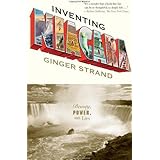
Average Reviews:

(More customer reviews)Are you looking to buy Inventing Niagara: Beauty, Power, and Lies? Here is the right place to find the great deals. we can offer discounts of up to 90% on Inventing Niagara: Beauty, Power, and Lies. Check out the link below:
>> Click Here to See Compare Prices and Get the Best Offers
Inventing Niagara: Beauty, Power, and Lies ReviewThere may be many reasons for going to Niagara Falls. Sure, you have to be awed by the spectacular falls themselves. You might go to start up a marriage, or to re-start one. You might go gamble. "I went to Niagara Falls because I wanted to laugh at it," says Ginger Strand, author of _Inventing Niagara: Beauty, Power, and Lies_ (Simon and Schuster), and she finds plenty of the historical and regional environs funny. But wanting to laugh was the reason she went there during her college years, just to smirk at the tackiness and kitsch. She has been going back, though, over and over since then, because "I do love hydroinfrastructure - water tunnels, reservoirs, canals, sewers, aqueducts." She finds it inspiring, but she also finds that the natural wonder that everyone loves about the falls is not natural at all. It has been used, changed, prettified, trivialized, exploited, and poisoned. There is thus a great deal of amusement in this wide-ranging account, but a good deal of loss and sadness as well."Niagara Falls as a natural wonder does not exist anymore." It is originally hard to believe this. It is not surprising that the water does not fall exactly as it did three hundred, or three thousand, years ago, but it is surprising how much people have made the changes happen in recent years. This is not entirely because of using the water for hydroelectric power, although this is certainly one cause of the change. The waterfall has hours of operation. In the summer, and during the daytime, when people come to see the falls in action, the water gets turned up to maximum flow. At night, it gets dialed back "like a fancy massaging showerhead" so that more electricity is generated. No more than half the water that could go over the falls actually does so, and an engineer assures Strand that yes, if they wanted, the power companies could divert all the water to the generators with none for the tourists. The effect on the scenery of the reduced flow has been minimized by huge engineering projects, tinkering with the flow and diverting it so that it goes evenly over Horseshoe Falls, for instance. The fall of the water is not all that has changed, of course. The "Free Niagara" movement, guided by the famous landscape architect Frederic Law Olmsted, proposed to make the surroundings of the falls to be picturesque and spiritually elevating. Strand writes that this was questionable social engineering. Worse than that, it hid the hydrodynamic and chemical exploitation of the area as industry sprang up to take advantage of the water's power. Only later did atrocities like the toxic dumps of the Love Canal come to light. There is a long history of utopian dreams for the region, but few of them have come true.
Much of Strand's book is therefore distressing. Humans have tried to do what they always try to do, take control of nature for reasons esthetic, and especially commercial, and whatever successes have come are inextricably linked to failures. The pessimism does not mean that Strand's book is preachy. There are stories of shrunken heads here, and Jo-Jo the Dog-Faced Boy, and fake Indian legends, and of course the peculiar thrills of those who go over the falls in barrels. There is a great deal of fun here. Strand writes, "On every level, Niagara Falls is a monument to the ways America falsifies its relationship to nature, reshaping its contours, redirecting its force, claiming to submit to its will while imposing our own upon it." There is plenty of documentation here of this theme, but Strand still travels to Niagara every chance she gets. She is continually amazed at the landfills or the other examples of disharmony with nature, but that's not important. The real amazement, and she writes about it heartily and endearingly, comes from the big, green spectacle of water, falling. Anyone reading this entertaining account will understand how well-placed is her obsession.
Inventing Niagara: Beauty, Power, and Lies Overview
Want to learn more information about Inventing Niagara: Beauty, Power, and Lies?
>> Click Here to See All Customer Reviews & Ratings Now
0 comments:
Post a Comment